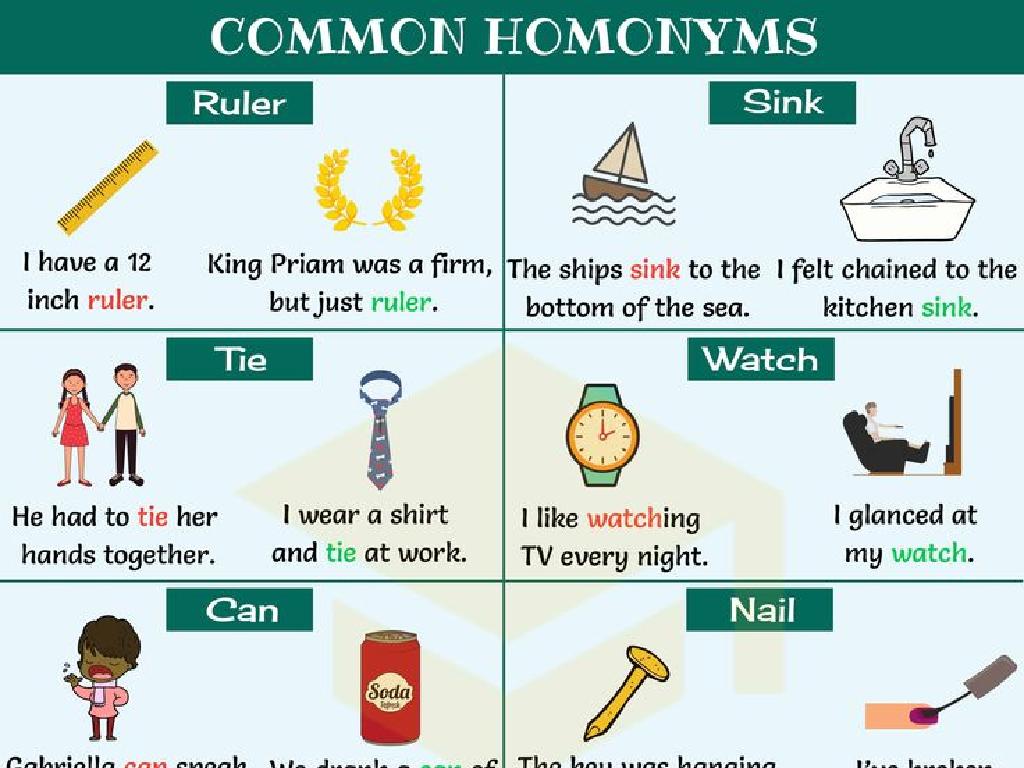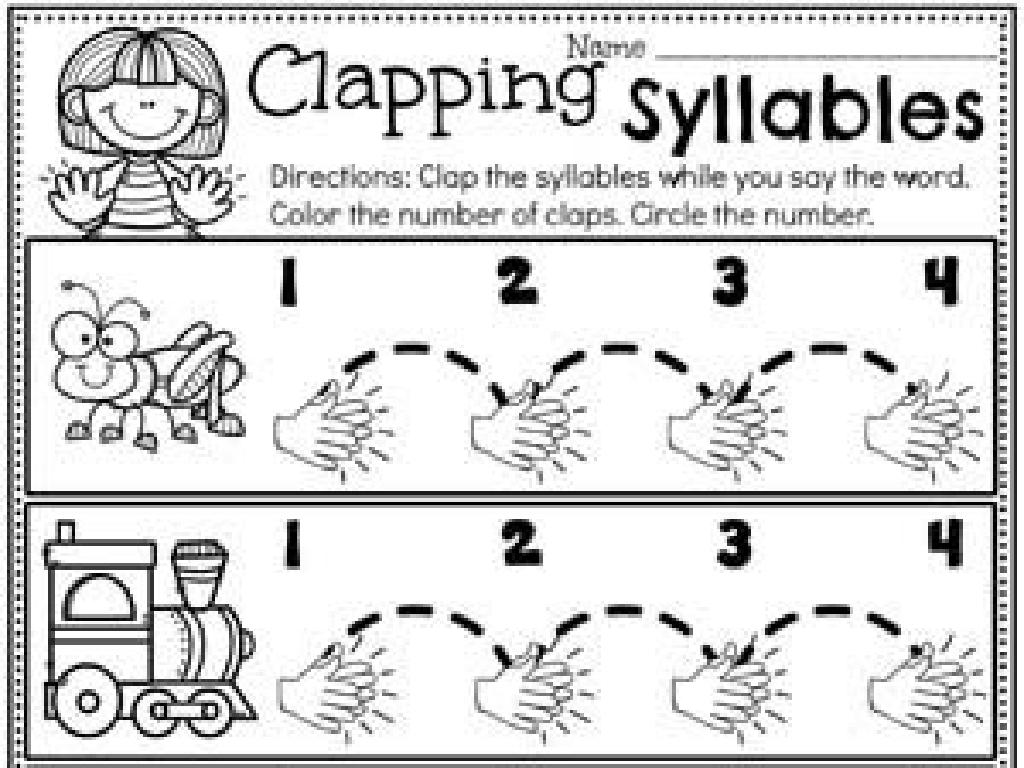Fractions Of A Number
Subject: Math
Grade: Fourth grade
Topic: Multiply Fractions And Whole Numbers
Please LOG IN to download the presentation. Access is available to registered users only.
View More Content
Introduction to Fractions: Parts of a Whole
– Understanding fractions concept
– A fraction represents a part of a whole.
– What exactly are fractions?
– It’s like a piece of a pizza or a slice of cake.
– Fractions in daily life
– Using fractions when cooking or dividing treats.
– Practice with real examples
– Let’s find fractions in things like 1/2 a sandwich or 3/4 of a jug of water.
|
This slide introduces the concept of fractions to fourth-grade students by relating it to familiar items in their everyday lives. Begin by explaining that a fraction represents a part of a whole, using tangible examples such as pieces of pizza or slices of cake to illustrate the point. Emphasize that fractions are everywhere, from sharing food to measuring ingredients in recipes. Encourage students to think of their own examples of fractions they encounter daily. Conclude by providing practice opportunities with real-life examples to solidify their understanding of fractions as parts of a whole.
Multiplying Fractions by Whole Numbers
– Multiply fraction by a whole number
– To multiply, use the whole number as a multiplier for the numerator.
– Find a part of a number using multiplication
– If you have 3/4 of a group of 8, multiply 3/4 by 8 to find the part.
– Visual example with pizza
– Imagine 3 groups of 1/4 slices of a whole pizza to understand multiplication.
|
This slide introduces the concept of multiplying fractions by whole numbers. Start by explaining that when you multiply a fraction by a whole number, you’re essentially adding that fraction to itself as many times as the whole number indicates. For example, 3 x (1/4) means you have three groups of one-fourth. Use visual aids like a pizza divided into quarters to illustrate this concept, as it’s relatable and easy to understand. Have students draw their own examples or use fraction tiles to reinforce the concept. Encourage them to think of other real-life examples where they might use this type of multiplication.
Multiplying Fractions by Whole Numbers
– Grasp the fraction’s meaning
– A fraction like 1/2 means one part out of two
– Multiply numerator by the whole number
– If you have 1/2 and you multiply by 4, it’s 1/2 * 4/1
– Simplify the fraction if needed
– Reduce the fraction to its simplest form, e.g., 4/2 becomes 2/1, which is 2
|
This slide aims to break down the process of multiplying fractions by whole numbers into manageable steps for fourth-grade students. Begin by ensuring students understand what a fraction represents a part of a whole. Then, demonstrate how to multiply the numerator (the top number) by the whole number while keeping the denominator (the bottom number) the same. Finally, guide students through simplifying the resulting fraction to its lowest terms, if possible. Use visual aids and examples to illustrate each step, and provide practice problems for students to apply these steps independently.
Practicing Fraction Multiplication
– Multiply whole number by fraction
– Example 1: 2 x (3/5)
– 2 times 3/5 equals what?
– Example 2: 4 x (1/2)
– 4 times 1/2 equals what?
– Solve step by step together
– We’ll break down each step
|
This slide is designed to provide students with practice problems to reinforce their understanding of multiplying whole numbers by fractions. Start by explaining the process of multiplying a whole number by a fraction. For Example 1, show that multiplying 2 by 3/5 means adding 3/5 two times. For Example 2, demonstrate that multiplying 4 by 1/2 is the same as finding half of 4. Walk through each problem step by step, ensuring students understand how to multiply across the numerator and keep the denominator the same. Encourage students to visualize the problems with drawings or objects if necessary. After explaining, give students time to try similar problems on their own to solidify their understanding.
Real-World Fractions: Multiplication in Daily Life
– Multiplying fractions while cooking
– Use 1/2 or 1/4 cup measurements for recipes
– Dividing pizza with friends
– If 8 friends share 2 pizzas, how much does each get?
– Understanding money with fractions
– Relate quarters, dimes, and nickels to fractions
– Practice with real examples
|
This slide aims to show students how the multiplication of fractions is applied in everyday situations. When cooking, we often use fractions like 1/2 cup of sugar or 1/4 teaspoon of salt. By understanding how to multiply these fractions, students can adjust recipes according to their needs. Dividing a pizza among friends is a practical way to visualize fractions and understand equal shares. Money is another excellent example, as coins can be used to represent fractions of a dollar. Encourage students to bring in examples from their experiences where they use fractions. This will help solidify their understanding and make learning math more engaging and relevant.
Class Activity: Fraction Multiplication with Objects
– Group activity setup
– Divide objects into fractions
– If you have 12 apples, how can you split them into halves?
– Multiply to find individual shares
– If each person gets 1/4 of the apples, how many apples does each get?
– Discuss results with the class
– Share how many objects each person received and how you found out.
|
This interactive group activity is designed to help students understand the concept of multiplying whole numbers by fractions through hands-on experience. Divide the class into small groups and provide each group with a set of objects, such as counters, fruit, or blocks. Guide them to divide the objects into equal parts representing fractions. Then, instruct them to apply multiplication to determine how many objects each group member should receive if they were to get a specific fraction of the total. For example, if there are 12 objects and each person gets 1/4, they should find out that each person gets 3 objects. After the activity, have a discussion where each group explains their method and findings. This will reinforce their understanding and allow them to see different approaches to the problem.
Wrapping Up: Fractions Multiplication
– Review: Multiplying fractions by whole numbers
– Homework: Worksheet on multiplying fractions
– Complete the provided worksheet to practice today’s lesson
– Upcoming quiz: Study fractions
– Prepare for a quiz on fractions during our next math class
– Practice makes perfect!
|
As we conclude today’s lesson on multiplying fractions by whole numbers, it’s important to reinforce the concept through practice. The homework worksheet is designed to solidify students’ understanding and prepare them for the upcoming quiz. Remind students of the steps we’ve learned: converting whole numbers to fractions, multiplying numerators, and simplifying if possible. Encourage them to review their notes and reach out if they have questions. The quiz will cover all aspects of fractions we’ve studied, so thorough preparation is key. Remember, consistent practice is the best way to master math skills!


/historical_maps_global_age.jpg)



